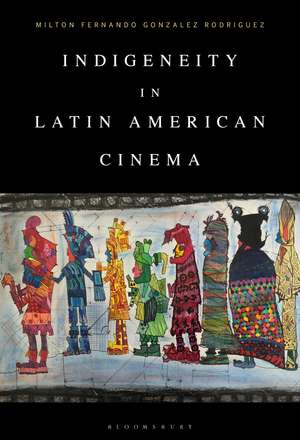Indigeneity in Latin American Cinema
Autor Milton Fernando Gonzalez Rodriguezen Limba Engleză Hardback – 24 aug 2022
| Toate formatele și edițiile | Preț | Express |
|---|---|---|
| Paperback (1) | 193.45 lei 6-8 săpt. | |
| Bloomsbury Publishing – 20 mar 2024 | 193.45 lei 6-8 săpt. | |
| Hardback (1) | 600.06 lei 6-8 săpt. | +128.34 lei 6-12 zile |
| Bloomsbury Publishing – 24 aug 2022 | 600.06 lei 6-8 săpt. | +128.34 lei 6-12 zile |
Preț: 600.06 lei
Preț vechi: 859.52 lei
-30% Nou
Puncte Express: 900
Preț estimativ în valută:
114.82€ • 119.88$ • 95.03£
114.82€ • 119.88$ • 95.03£
Carte tipărită la comandă
Livrare economică 04-18 aprilie
Livrare express 27 februarie-05 martie pentru 138.33 lei
Preluare comenzi: 021 569.72.76
Specificații
ISBN-13: 9781501384707
ISBN-10: 1501384708
Pagini: 336
Ilustrații: 5 bw illus
Dimensiuni: 152 x 229 x 27 mm
Greutate: 0.61 kg
Editura: Bloomsbury Publishing
Colecția Bloomsbury Academic
Locul publicării:New York, United States
ISBN-10: 1501384708
Pagini: 336
Ilustrații: 5 bw illus
Dimensiuni: 152 x 229 x 27 mm
Greutate: 0.61 kg
Editura: Bloomsbury Publishing
Colecția Bloomsbury Academic
Locul publicării:New York, United States
Caracteristici
Reviews some of the most popular Latin American films of the last two decades, as many of them include indigenous characters, including the Oscar-winning Roma (2018)
Notă biografică
Milton Fernando Gonzalez Rodriguez is a Marie Sklodowska Curie Fellow at the Faculty of Arts, KU Leuven, Belgium, and author of Ontologies and Natures: Knowledge about Health and Visual Culture (2022). The focus of his research lies on the historical evolution, circulation and materialization of representations, artefacts and ideas from a visual, linguistic and epistemic perspective. His previous and current affiliations include the University of Iceland and University of Amsterdam, the Netherlands.
Cuprins
AcknowledgementsList of DiagramsList of FiguresList of TablesBasis: IntroductionIndigeneity: Conceptualization, Perception and Representation Syntonic versus Histrionic Indigeneity 1. Mimesis: Circulation of Ideas and Images Figment, Art and Fabrication Cinema and Indigeneity 2. Metropolis: Production of Audiovisual Cultural Artefacts Mexico and Central America South America 3. Lexis: Portrayals of Linguistic Topologies Accented Inclusion and Vocative Framing (In)discernible Sounds and Authenticity 4. Emphasis: Embodiment of Indigeneity Nature-Technology Nexus as an Ontological Genre Ethnicity, Senses and Knowledge 5. Axis: Identities and Global Imaginaries Intersectional Paradigms Arrayed Figures 6. Catalysis: Paradigms and Disruption (In)visibility and Representation (Re)drawn Blueprint 7. Wääjx äp: Epistemic and Ontological Repositioning The Cybernetics of Self-Representation Screen(ed)/(ing) Intimacy and Clusivity Synopsis / ConclusionReferencesBibliographyFilmographyIndex
Recenzii
This is an essential and highly original text that sharpens our understanding of the representation of indigeneity across Latin American cinema. It takes a much-needed interdisciplinary and decolonizing approach that disrupts older paradigms and reveals a richly diverse treatment of indigenous communities in film.
Indigeneity in Latin American Cinema is a tour de force; this book takes a bold approach to examining how contemporary indigenous representation in Latin American cinema has been subject to racist and othering practices through what Gonzalez Rodriguez convincingly calls "histrionic indigeneity" as these films circulate through international film festivals and other Global South-North trajectories. This frank look at contemporary practices is a must read for any scholars interested in the ways in which indigenous visual culture and the cinema has been imagined historically to the present day.
This book succeeds in going beyond the traditional approach in studying the Amerindian in global northern visual culture. In fact, anyone interested in the colonial heritage of the Americas should take careful note of the author's conclusions.
Gonzalez Rodriguez goes beyond traditional paradigms to offer an original, decolonizing approach yielding many provocative new cultural insights.
Indigeneity in Latin American Cinema is a tour de force; this book takes a bold approach to examining how contemporary indigenous representation in Latin American cinema has been subject to racist and othering practices through what Gonzalez Rodriguez convincingly calls "histrionic indigeneity" as these films circulate through international film festivals and other Global South-North trajectories. This frank look at contemporary practices is a must read for any scholars interested in the ways in which indigenous visual culture and the cinema has been imagined historically to the present day.
This book succeeds in going beyond the traditional approach in studying the Amerindian in global northern visual culture. In fact, anyone interested in the colonial heritage of the Americas should take careful note of the author's conclusions.
Gonzalez Rodriguez goes beyond traditional paradigms to offer an original, decolonizing approach yielding many provocative new cultural insights.
